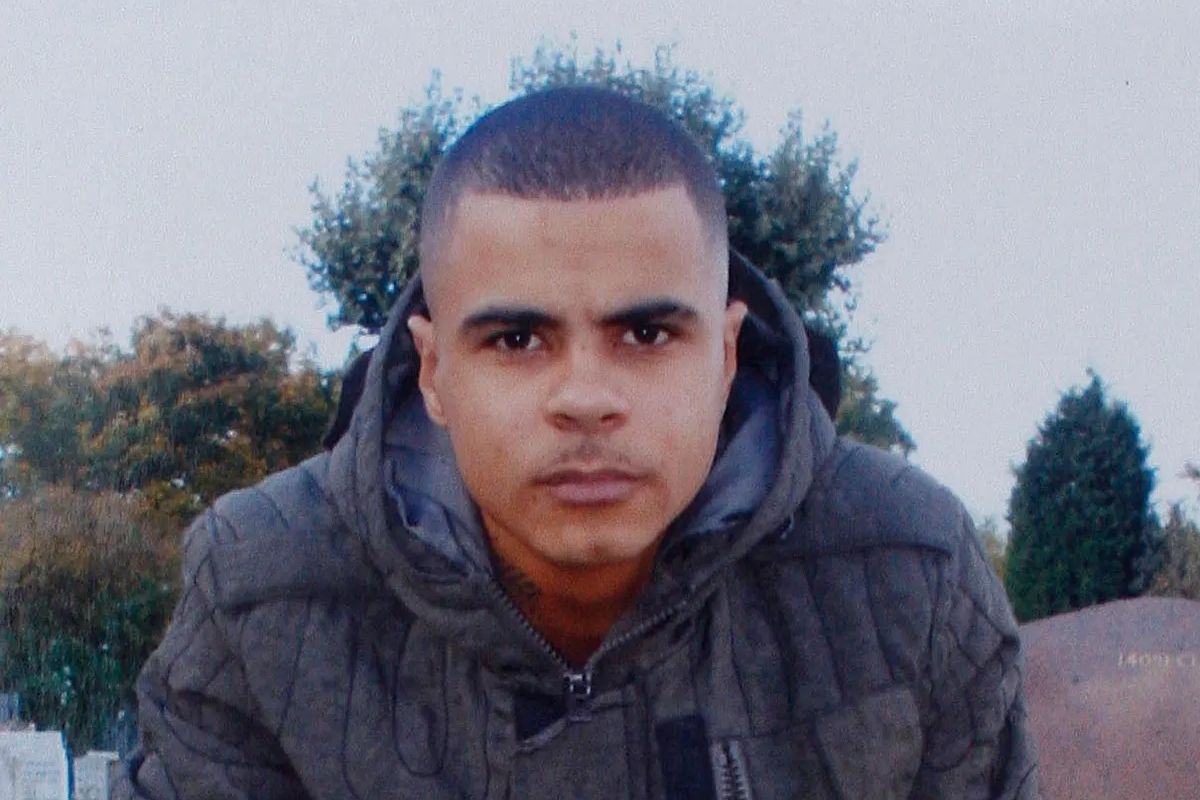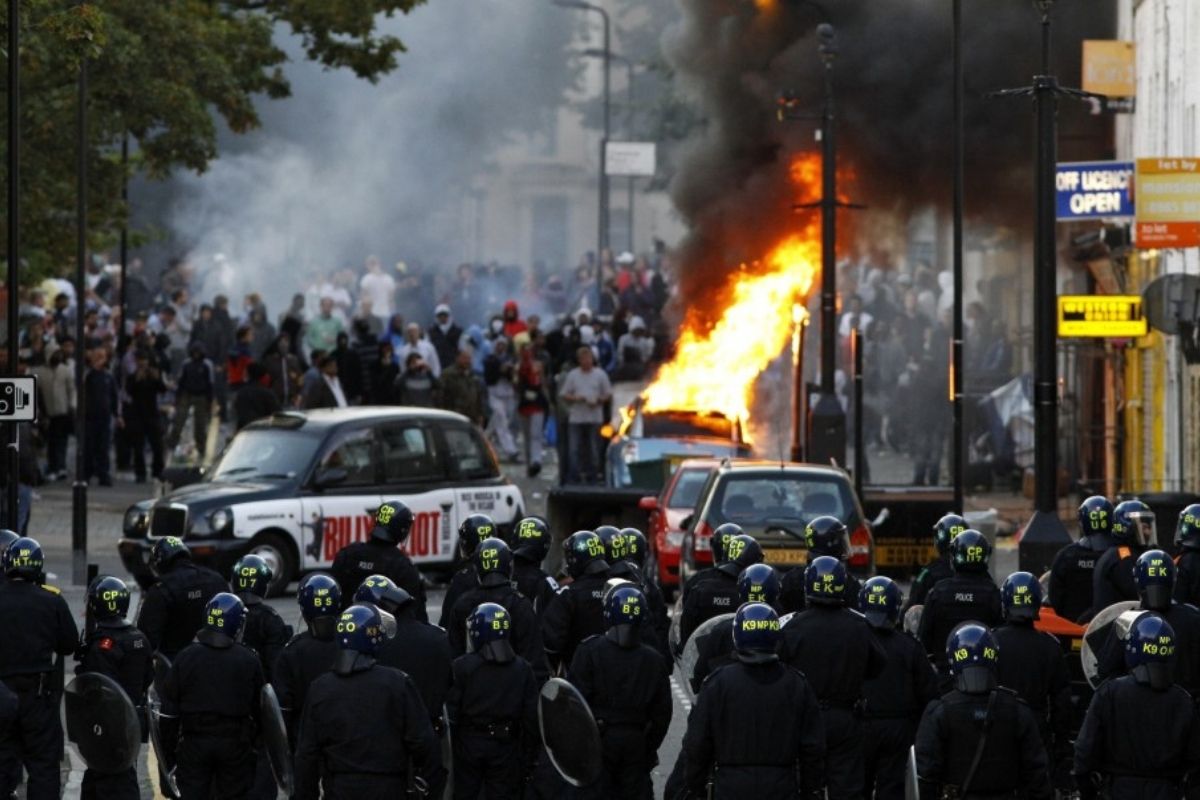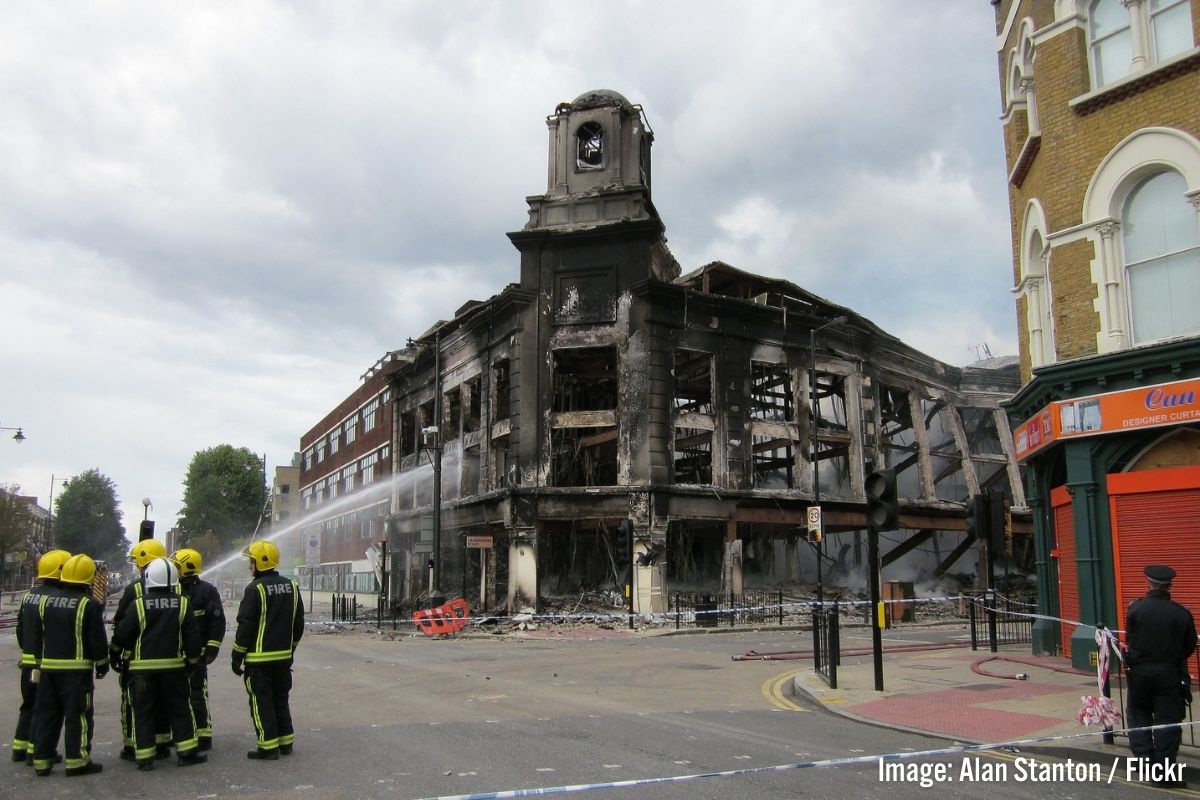Burning cars, broken glass, looting and an entire community enraged at the violent actions of those who are supposed to protect them. This describes the situation not in Greece or 80s Liverpool, but Tottenham, London on 6th August 2011. In this article we look at the background to these events demonstrate the underlying cause lies in the crisis of capitalism.
In the recent period the comparison has often been made between the current situation in Britain and the 1980s. With the eruption of rioting on the streets of London a mere a five months after the 30th Anniversary of the Brixton riots this comparison has perhaps never been more apt.
What is certainly true is that similar conditions create similar results and thus with a Tory led government carrying out brutal attacks on the working people of Britain it was inevitable that sooner or later we’d see a return to the social unrest that characterised the 80s.
A violent provocation

The catalyst for the events of Saturday night is an all too familiar story of police violence. On Thursday 4th August, a young man named Mark Duggan was shot dead by police in Tottenham. The circumstances surrounding the shooting are still not clear. The police claim that officers came under fire from a minicab in which Duggan was a passenger and they responded accordingly with the result that Duggan died at the scene and a police officer was injured.
It is clear that the police wished to give the impression that they only killed the young man in defence but their story is already beginning to unravel. An apparent eyewitness told the Evening Standard that Duggan was already handcuffed and on the ground when the shots were fired, a report which, if true, makes the killing sound more like an execution than innocent police officers firing in self defence.
Additionally the Guardian has reported that initial ballistics tests on a bullet found lodged in a radio worn by the officer injured during the incident, suggested it was police issue, making the claim that Duggan fired on the officer first sound increasingly unlikely.
Whatever the truth of the shooting turns out to be it is clear that we should treat the police’s version of events with extreme suspicion. Following the web of lies that were spun by the Met around the killings of Jean Charles De Menezes and Ian Tomlinson and their complicity in the phone hacking scandal it is plain to see that they cannot be trusted.
The community responds
Mark Duggan was a father of four and his family were understandably distraught at the news of his death. With limited information provided by the police and a suspicion of foul play his fiancee Semone Wilson decided to organise a protest.
200 protesters, consisting of local residents, community leaders, and some of Duggan’s relatives, gathered outside Tottenham police station at 5.30pm on Saturday 6th to demand answers. Reports indicate that the protesters were initially peaceful and good natured but the mood became increasingly angry as the police failed to engage with them.
A number of eyewitnesses report that the spark for the rioting came when a 16-year-old girl stepped forward to confront police around 8.30pm and the police responded by attacking her with shields and batons. Anthony Johnson is quoted in the Guardian as saying:
“They beat her with a baton, and then the crowd started shouting ‘run, run’, and there was a hail of missiles. She had been saying: ‘We want answers, come and speak to us.'”
Laurence Bailey corroborates the story saying she was “pounded by 15 riot shields” and “went down on the floor but once she managed to get up she was hit again before being half-dragged away by her friend”. A video has appeared on YouTube purporting to show the incident occurring while another witness has confirmed the story to the BBC.
With tensions already running high in the community following the killing of Duggan this incident was enough to spark the riot. As news of the attack spread violence throughout the area quickly escalated. By 11pm, a double-decker bus and several shops had been set alight as police fought running battles with the rioters along Tottenham High Street.
Question of Violence
Both the media and the government have inevitably focused on the incidents of looting and violence while excusing the police’s actions and failing to even consider the deep seated resentment that lies behind the incident. They are unanimous in both their support for the police and their condemnation of the people of Tottenham.
It is after all a familiar story following the wave of protests that have swept Britain since the NUS demonstration last Autumn. We are routinely told by the press that there is ‘no excuse’ for such ‘disgusting’ violence such as the attack on Millbank tower.
But regardless of its tactical effectiveness as a means of protest property damage is not real violence. Smashing a few windows or nicking some trainers from footlocker doesn’t actually physically hurt anyone and in most cases is a perfectly understandable response, however desperate, to the violence of the police and the state.
Capitalism on the other hand wreaks violence upon society on a daily basis: from dire poverty and famine through to the very police brutality that sparked this whole incident. As agents of the ruling class both the State and the media are totally complicit in such violence and thus have an interest in keeping it hidden from the masses. Footage of the deprived residents of Tottenham breaking into Aldi provides an all too convenient smoke screen.
The reality is of course that the people on the streets of Tottenham were not ‘violent’ criminals looking to line their pockets with stolen goods. They are simply a community that has been pushed to the edge by the economic system they live under and the police violence that supports it. As one rioter, Jamal, told Channel 4 News:
“We’re here to tell the police they can’t abuse us, harass us. We won’t put up with it. This is just the beginning, this is war, and this is what you get – fire.”
Role of the Police

As Engels explained over 120 years ago, the State, in the final analysis, is nothing more than armed bodies of men in defence of property relations. Those armed bodies of men are the army, the police and their corollary in the prison and judicial system while the property relations they defend is capitalism and private property.
As we have explained before British capitalism is in a deep crisis and the only way out for the bourgeoisie is to make the workers pay. That is why the government is intent on slashing public services and benefits, in effect waging war on the gains won by working people through struggle since WWII in order to restore profitability to the system.
But the bourgeoisie and their puppet rulers in the Conservatives and Liberal Democrats are not stupid. This is not the first time Britain has seen rioting, its not even the first time Tottenham has seen rioting. In 1985 rioting erupted on the Broadwater Estate (coincidentally where Mark Duggan is from) in response to police violence, in the context of previous riots in Brixton and Toxteth triggered by Tory policies similar to those being implemented today. Symeon Brown, a youth worker in Tottenham, who was interviewed by the BBC said that people must not “underestimate the power of collective memory” and this is something that government understands.
The truth is since they came to power the Coalition government have been expecting a response to their austerity programme and the police have been given free reign to control the growing discontent accordingly. Police violence towards protesters in the Student demonstrations in 2010, as well as the vicious clampdown on dissent around the Royal wedding and the ‘exemplary’ sentences handed out for minor protest offenses are all part of the same programme to discourage resistance and demonstrate to the bourgeoisie that the government are capable of maintaining control in the face of the coming class struggle.
A community on the edge
The riots in Tottenham must therefore be seen in context of a deep economic crisis and historically large cuts to public welfare. Tottenham is located in Harringey which was already in a bad state in 2007 prior to the recession, when it was ranked the 18th most deprived local authority in England out of 326.
In 2010, it’s ranking dropped to 13th with one out of two children living in poverty, demonstrating the devastating effect of the recession on a community already struggling under the weight of the capitalist system. Stafford Scott, a community activist in Tottenham, has drawn parallels to the situation in 1985 in an interview with Sky News:
“People need to realise… in this community, for these kids, everything is the same as 1985. How often they get stopped and searched has actually gone up. Unemployment against young people has actually gone up since 1985. Getting kicked out of school is the same or similarly high to 1985. Nothing has improved for the livelihoods of young black people who happen to find themselves growing up on estates like Broadwater Farm.”
Unemployment is particularly bad in Tottenham with figures from March showing eight per cent of the adult population are on the dole, making it the tenth highest for unemployment benefit claims in the UK. Of coure these figures show only the number of people able to claim benefits; the real rate of unemployment will be much higher.
With the government’s austerity measures resulting in the loss of funding for several local community projects and programmes the situation will become even more difficult for the local youth. John McDonnel MP has illustrated the depth of these cuts in a Labour Representation Committee (LRC) statement:
“In March Haringey Council approved cuts of £84 million from a total budget of £273 million. There was a savage 75% cut to the Youth Service budget, including: closing the youth centres; connexions careers advice service for young people reduced by 75%; and the children’s centre service reduced.”
Margaret Thatcher dismissed the notion that unemployment and racism lay beneath the Brixton riot claiming “Nothing, but nothing, justifies what happened” and today’s Tories make similar claims. But this is to excuse the fact their policies and the economic system they defend are ultimately culpable for these events.
The killing of Mark Duggan was undoubtedly a tragedy but in reality it was not the underlying cause of the riot; it was just the spark. The bonfire had been prepared by years of poverty and neglect, fueled by the anger of young people who see no prospects for themselves and lash out at the system they correctly deem responsible for their lack of a future.
This tragedy is compounded by the complete lack of leadership from a labour movement that should be inspiring these youth by leading the fight for an alternative to this system of exploitation and misery.
A system in crisis
In this period a simple glance at a newspaper on any given day should be enough to demonstrate that there is something profoundly wrong with the world we live in. All across the globe the effects of the what could very well be the deepest crisis in the history of capitalism are felt in titanic explosions of struggle.
From the momentous events of the Arab Spring to the recent waves of protest in Israel and Chile the working people of the world are engaged in a shared struggle to improve their lives. While the events in Tottenham may not seem connected they share the same underlying cause.
Almost everywhere you look in the world the same conditions exist. Historically high youth unemployment, rising food prices and heavily indebted governments looking to pass on the bill for the crisis by attacking their own working class. As we have said similar conditions produce similar results. As such the events in Tottenham are merely a precursor of greater struggles to come.






